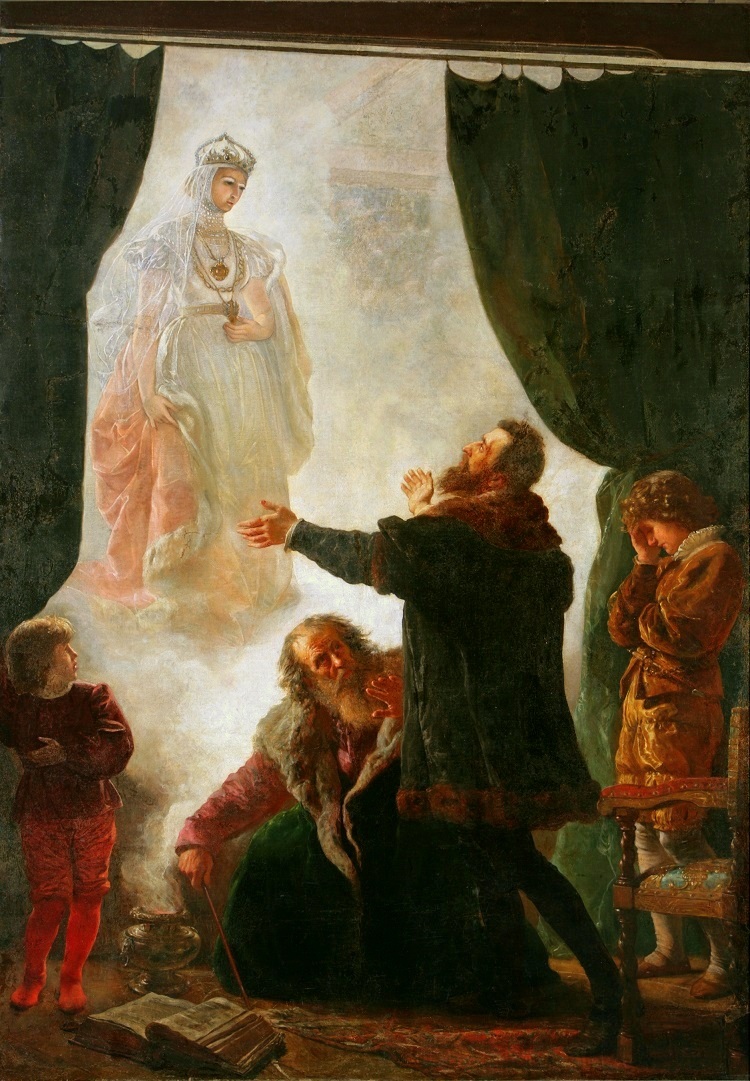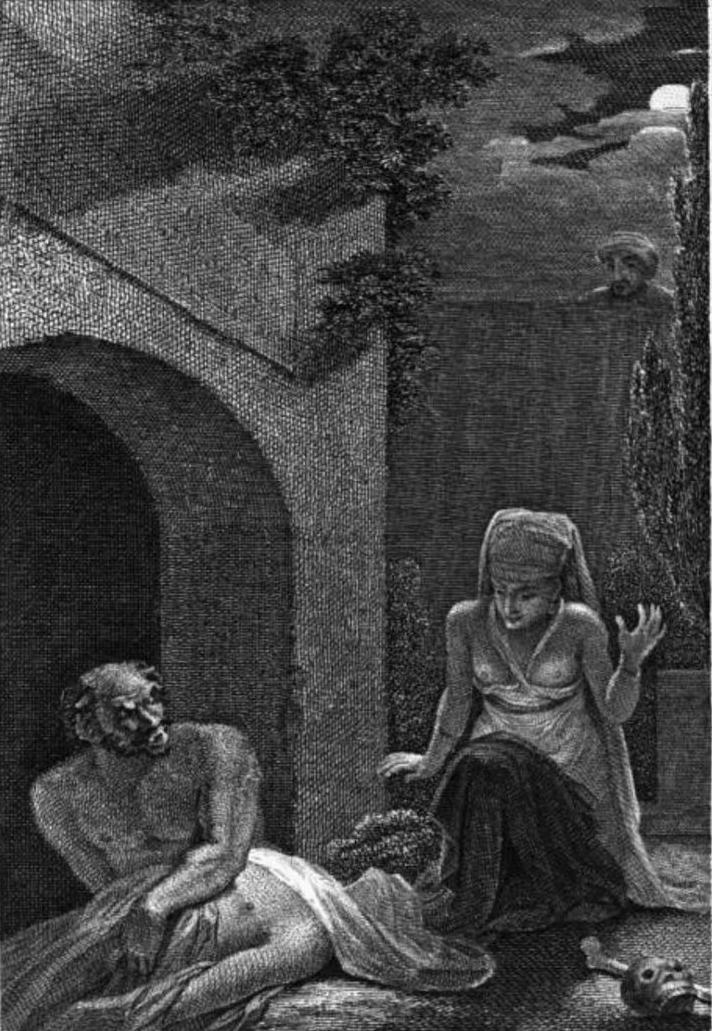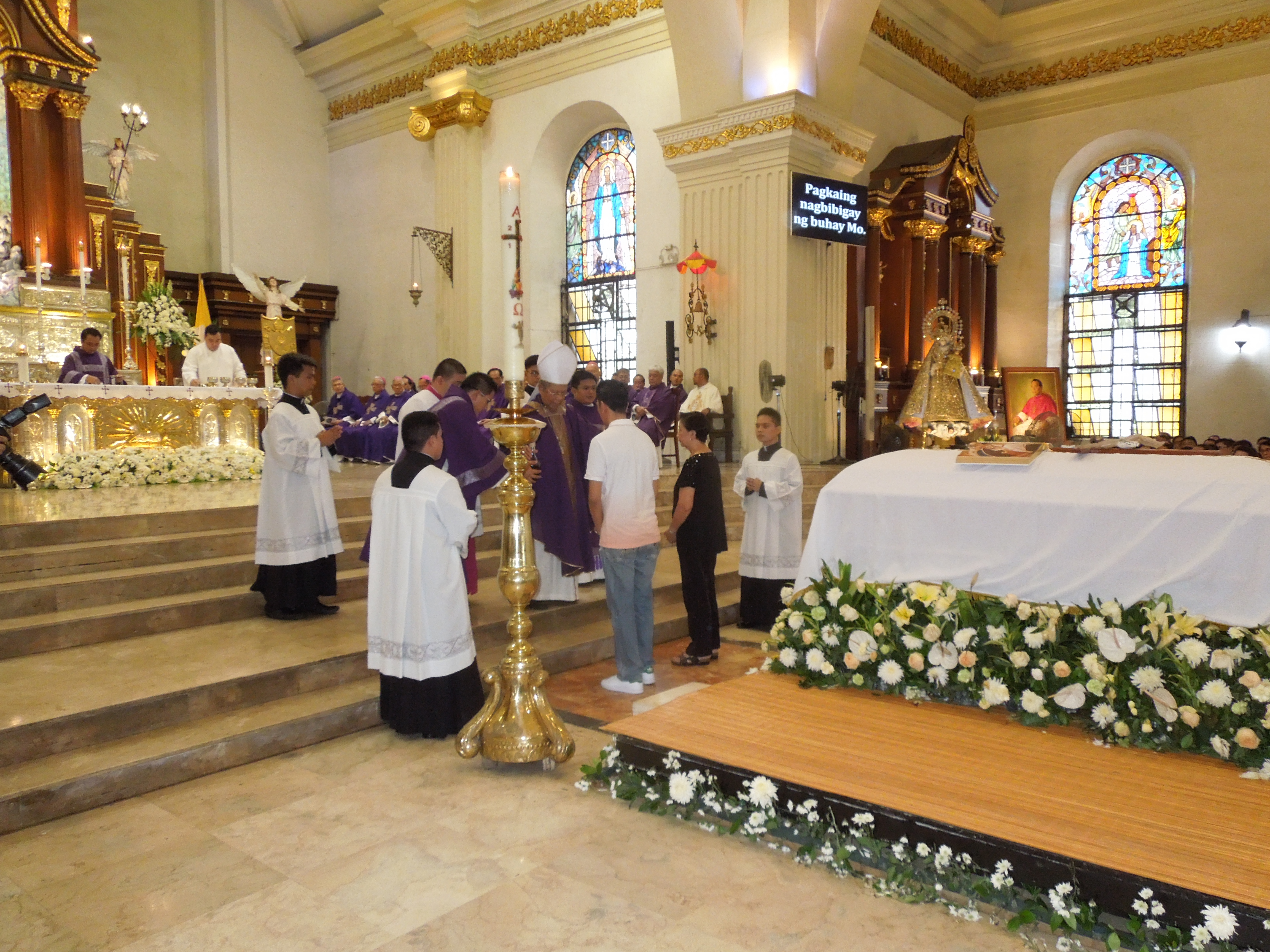|
Jikininki
appear in Lafcadio Hearn's '' Kwaidan: Stories and Studies of Strange Things'' (1904) as corpse-eating spirits. In Japanese Buddhism, ''jikininki'' ("human-eating ghosts"; pronounced ''shokujinki'' in modern Japanese), are similar to '' Gaki''/''Hungry ghost''; the spirits of greedy, selfish or impious individuals who are cursed after death to seek out and eat humans and human corpses. The supernatural species known as Jijinki (or Phantasm) is the byproduct of a pregnant woman outsmarting a corpse-eater. A similar story can be found as "Aozukin" in Ueda Akinari's ''Ugetsu Monogatari'' from 1776. Story It is said that there was a monk/priest, named Muso, who was traveling alone through the mountains in the Mino prefecture of Japan, when he lost his way. It was almost dark when he saw, up on a hill, an old , the home of solitary priests. He walked to the top of the hill and asked the inhabitant if he could stay the night. The only inhabitant was an old priest, who harshly refused ... [...More Info...] [...Related Items...] OR: [Wikipedia] [Google] [Baidu] |
Hungry Ghost
Hungry ghost is a concept in Buddhism, and Chinese traditional religion, representing beings who are driven by intense emotional needs in an animalistic way. The terms ' literally "hungry ghost", are the Chinese translation of the term '' preta'' in Buddhism. "Hungry ghosts" play a role in Chinese Buddhism and Taoism as well as in Chinese folk religion The term is not to be confused with the generic term for "ghost" or damnation, ' (i.e. the residual spirit of a deceased ancestor). The understanding is that all people become such a regular ghost when they die,Venerable Yin-shun. ''The Way to Buddhahood''. Massachusetts: Wisdom Publications: 1998. and would then slowly weaken and eventually die a second time.Eberhard, Stephen F. ''The Ghost Festival in Medieval China''. New Jersey: Princeton University Press: 1988. Hungry ghosts, by contrast, are a much more exceptional case, and would only occur in very unfortunate circumstances, such as if a whole family were killed or w ... [...More Info...] [...Related Items...] OR: [Wikipedia] [Google] [Baidu] |
Segaki
The is a ritual of Japanese Buddhism, traditionally performed to stop the suffering of the such restless ghosts/monsters as '' gaki'', ''jikininki'' and the ''muenbotoke'' (the dead who have no living relatives), ghosts tormented by insatiable hunger. Alternatively, the ritual forces them to return to their portion of hell or keeps the spirits of the dead from falling into the realm of the gaki. The segaki may be performed at any time, but traditionally performed as part of the yearly '' Urabon'e'' ( sa, उल्लम्बन ''Ullambana'') services in July to remember the dead and the segaki ritual for offering alms to specifically hungry gaki or muenbotoke, not for spirits of one's ancestor. The ritual is held at Buddhist temples and there is a custom to place segaki-dana (rack for gaki) or gaki-dana (shelf for gaki) at home, present offerings (traditionally rice and water) for hungry ghosts who are wandering in this world as muenbotoke during Urabon'e or O-bon. The segaki be ... [...More Info...] [...Related Items...] OR: [Wikipedia] [Google] [Baidu] |
Ghost
A ghost is the soul (spirit), soul or spirit of a dead Human, person or animal that is believed to be able to appear to the living. In ghostlore, descriptions of ghosts vary widely from an invisible presence to translucent or barely visible wispy shapes, to realistic, lifelike forms. The deliberate attempt to contact the spirit of a deceased person is known as necromancy, or in spiritism as a ''séance''. Other terms associated with it are apparition, haunt, phantom, poltergeist, shade, specter or spectre, spirit, spook, wraith, demon, and ghoul. The belief in the existence of an afterlife, as well as manifestations of the spirits of the dead, is widespread, dating back to animism or ancestor worship in pre-literate cultures. Certain religious practices—funeral rites, exorcisms, and some practices of spiritualism and ritual magic—are specifically designed to rest the spirits of the dead. Ghosts are generally described as solitary, human-like essences, though stories of ... [...More Info...] [...Related Items...] OR: [Wikipedia] [Google] [Baidu] |
Hamlet (place)
A hamlet is a human settlement that is smaller than a town or village. Its size relative to a parish can depend on the administration and region. A hamlet may be considered to be a smaller settlement or subdivision or satellite entity to a larger settlement. The word and concept of a hamlet has roots in the Anglo-Norman settlement of England, where the old French ' came to apply to small human settlements. Etymology The word comes from Anglo-Norman ', corresponding to Old French ', the diminutive of Old French ' meaning a little village. This, in turn, is a diminutive of Old French ', possibly borrowed from ( West Germanic) Franconian languages. Compare with modern French ', Dutch ', Frisian ', German ', Old English ' and Modern English ''home''. By country Afghanistan In Afghanistan, the counterpart of the hamlet is the qala ( Dari: قلعه, Pashto: کلي) meaning "fort" or "hamlet". The Afghan ''qala'' is a fortified group of houses, generally with its ... [...More Info...] [...Related Items...] OR: [Wikipedia] [Google] [Baidu] |
Undead
The undead are beings in mythology, legend, or fiction that are deceased but behave as if alive. Most commonly the term refers to corporeal forms of formerly-alive humans, such as mummies, vampires, and zombies, who have been reanimated by supernatural means, technology, or disease. In some cases (for example in Dungeons & Dragons) the term also includes incorporeal forms of the dead, such as ghosts. The undead are featured in the belief systems of most cultures, and appear in many works of fantasy and horror fiction. The term is also occasionally used for real-life attempts to resurrect the dead with science and technology, from early experiments like Robert E. Cornish's to future sciences such as "chemical brain preservation" and " cryonics." History Bram Stoker considered using the title, ''The Un-Dead'', for his novel '' Dracula'' (1897), and use of the term in the novel is mostly responsible for the modern sense of the word. The word does appear in English before ... [...More Info...] [...Related Items...] OR: [Wikipedia] [Google] [Baidu] |
Japanese Ghosts
Japanese may refer to: * Something from or related to Japan, an island country in East Asia * Japanese language, spoken mainly in Japan * Japanese people, the ethnic group that identifies with Japan through ancestry or culture ** Japanese diaspora, Japanese emigrants and their descendants around the world * Japanese citizens, nationals of Japan under Japanese nationality law ** Foreign-born Japanese, naturalized citizens of Japan * Japanese writing system, consisting of kanji and kana * Japanese cuisine, the food and food culture of Japan See also * List of Japanese people * * Japonica (other) * Japonicum * Japonicus * Japanese studies Japanese studies ( Japanese: ) or Japan studies (sometimes Japanology in Europe), is a sub-field of area studies or East Asian studies involved in social sciences and humanities research on Japan. It incorporates fields such as the study of Japane ... {{disambiguation Language and nationality disambiguation pages ... [...More Info...] [...Related Items...] OR: [Wikipedia] [Google] [Baidu] |
Buddhist Legendary Creatures
Buddhism ( , ), also known as Buddha Dharma and Dharmavinaya (), is an Indian religion or philosophical tradition based on teachings attributed to the Buddha. It originated in northern India as a -movement in the 5th century BCE, and gradually spread throughout much of Asia via the Silk Road. It is the world's fourth-largest religion, with over 520 million followers (Buddhists) who comprise seven percent of the global population. The Buddha taught the Middle Way, a path of spiritual development that avoids both extreme asceticism and hedonism. It aims at liberation from clinging and craving to things which are impermanent (), incapable of satisfying ('), and without a lasting essence (), ending the cycle of death and rebirth (). A summary of this path is expressed in the Noble Eightfold Path, a training of the mind with observance of Buddhist ethics and meditation. Other widely observed practices include: monasticism; " taking refuge" in the Buddha, the , and the ; a ... [...More Info...] [...Related Items...] OR: [Wikipedia] [Google] [Baidu] |
Ghoul
A ghoul ( ar, غول, ') is a demon-like being or monstrous humanoid. The concept originated in pre-Islamic Arabian religion, associated with graveyards and the consumption of human flesh. Modern fiction often uses the term to label a certain kind of undead monster. By extension, the word ghoul is also used in a derogatory sense to refer to a person who delights in the macabre or whose occupation directly involves death, such as a gravedigger or graverobber. Etymology Ghoul is from the Arabic ''ghūl'', from ''ghāla'', "to seize". In Arabic, the term is also sometimes used to describe a greedy or gluttonous individual. See also the etymology of gal and gala: "to cast spells," "scream," "crow," and its association with "warlike ardor," "wrath," and the Akkadian " gallu," which refer to demons of the underworld. The term was first used in English literature in 1786 in William Beckford's Orientalist novel ''Vathek'', which describes the ''ghūl'' of Arabic folklore ... [...More Info...] [...Related Items...] OR: [Wikipedia] [Google] [Baidu] |
Gashadokuro
Utagawa Kuniyoshi's , also known as ''Takiyasha the Witch and the Skeleton Spectre'' are Yōkai, mythical creatures in modern Japanese mythology. Description The Gashadokuro is a spirit that take the form of giant Skeleton (undead), skeletons made of the skulls of people who died in the field, and is 10 meters tall. Only the eyes protrude, and some sources describe them as burning yellow or green. Gashadokuro wanders around at 2:00 a.m. and attacks and eats humans when it sees them. When a gashadokuro approaches, it is said to make a clattering sound with its teeth. The following characteristics are not confirmed by Japanese data. The Gashadokuro are said to possess the powers of invisibility and indestructibility since it is composed of the bones of people who are already deceased, though Shinto charms are said to ward them off. Otherwise, a Gashadokuro will continue hunting its prey until its pent up anger is released, causing the bones to crumple and the Gashadokuro to collaps ... [...More Info...] [...Related Items...] OR: [Wikipedia] [Google] [Baidu] |
Requiem
A Requiem or Requiem Mass, also known as Mass for the dead ( la, Missa pro defunctis) or Mass of the dead ( la, Missa defunctorum), is a Mass of the Catholic Church offered for the repose of the soul or souls of one or more deceased persons, using a particular form of the Roman Missal. It is usually celebrated in the context of a funeral (where in some countries it is often called a Funeral Mass). Musical settings of the propers of the Requiem Mass are also called Requiems, and the term has subsequently been applied to other musical compositions associated with death, dying, and mourning, even when they lack religious or liturgical relevance. The term is also used for similar ceremonies outside the Roman Catholic Church, especially in Western Rite Orthodox Christianity, the Anglo-Catholic tradition of Anglicanism, and in certain Lutheran churches. A comparable service, with a wholly different ritual form and texts, exists in the Eastern Orthodox and Eastern Catholic chu ... [...More Info...] [...Related Items...] OR: [Wikipedia] [Google] [Baidu] |
Corpse
A cadaver or corpse is a dead human body that is used by medical students, physicians and other scientists to study anatomy, identify disease sites, determine causes of death, and provide tissue to repair a defect in a living human being. Students in medical school study and dissect cadavers as a part of their education. Others who study cadavers include archaeologists and arts students. The term ''cadaver'' is used in courts of law (and, to a lesser extent, also by media outlets such as newspapers) to refer to a dead body, as well as by recovery teams searching for bodies in natural disasters. The word comes from the Latin word ''cadere'' ("to fall"). Related terms include ''cadaverous'' (resembling a cadaver) and ''cadaveric spasm'' (a muscle spasm causing a dead body to twitch or jerk). A cadaver graft (also called “postmortem graft”) is the grafting of tissue from a dead body onto a living human to repair a defect or disfigurement. Cadavers can be observed for their ... [...More Info...] [...Related Items...] OR: [Wikipedia] [Google] [Baidu] |




